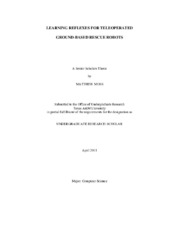| dc.description.abstract | This thesis presents a system for shared autonomy, where a search and rescue robot uses training data to create a "maintain balance" reflex to enable a robot to autonomously stop, back up, or change configuration to avoid falling over as the operator drives it through rubble. Currently, the operator is responsible for determining if the robot is in an unsafe state and about to fall. Falling over often ends the mission for the robot. With a "maintain balance" reflex, the operator can drive the robot with less risk of falling over. This project required retrofitting an ASR/Inuktun Extreme variable geometry robot with an Analog Devices ADXL335 3-axis accelerometer to provide inputs for a fall classifier optimized by a genetic algorithm. The software system written in C# uses a Subsumption Architecture, where the reflex takes priority over operator commands that place the robot in danger. The developed system was tested over 3 trials, 2 with the NIST Standard Test Method for Response Robots: Mobility: Terrain: Stepfields. 4 variants of the system and a control were compared for effectiveness. Over the 3 trials each variant was tested with 45 starting configurations. Variants of the system demonstrated an 8% decrease in the probability of falling on a simple climbing stepfield, and a 40% decrease on flat terrain. The results show that the primary mechanism for reducing falls is backing up, which shows a 6% improvement over halting in terms of fall probability. The small improvement reflects the lack of agility and sensing limitations of the robot, the data suggests the classification algorithm was an appropriate choice, as it responds to situations not captured by a simple physically based model. This work is expected to be useful for other search and rescue robots; each type of robot would have to be trained using the procedures described in this thesis. | en |


